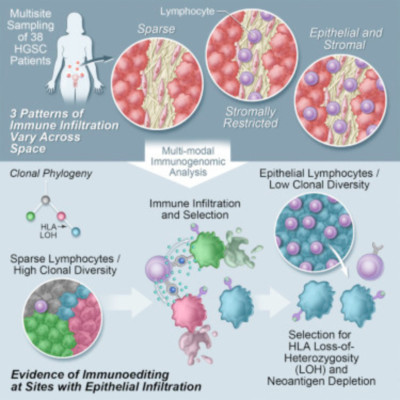Abstract
High-grade serous ovarian cancer (HGSC) exhibits extensive malignant clonal diversity with widespread but non-random patterns of disease dissemination. We investigated whether local immune microenvironment factors shape tumor progression properties at the interface of tumor-infiltrating lymphocytes (TILs) and cancer cells. Through multi-region study of 212 samples from 38 patients with whole-genome sequencing, immunohistochemistry, histologic image analysis, gene expression profiling, and T and B cell receptor sequencing, we identified three immunologic subtypes across samples and extensive within-patient diversity. Epithelial CD8+ TILs negatively associated with malignant diversity, reflecting immunological pruning of tumor clones inferred by neoantigen depletion, HLA I loss of heterozygosity, and spatial tracking between T cell and tumor clones. In addition, combinatorial prognostic effects of mutational processes and immune properties were observed, illuminating how specific genomic aberration types associate with immune response and impact survival. We conclude that within-patient spatial immune microenvironment variation shapes intraperitoneal malignant spread, provoking new evolutionary perspectives on HGSC clonal dispersion.
